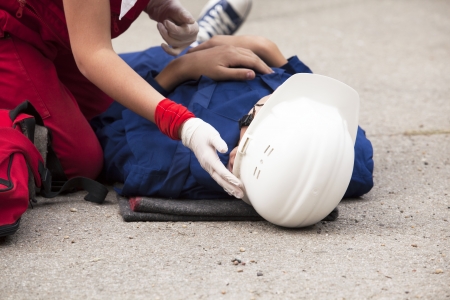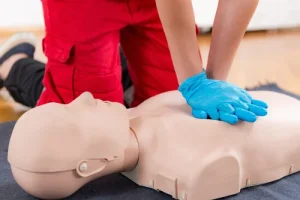Did you know that immediate CPR can double or triple a cardiac arrest victim’s chance of survival? Yet, nearly 70% of Americans feel helpless during emergencies because they lack training. Whether you’re a student, healthcare worker, or concerned citizen, understanding CPR (Cardiopulmonary Resuscitation), AED (Automated External Defibrillator), and First Aid can make the difference between life and death.
 What Are CPR, AED, and First Aid?
What Are CPR, AED, and First Aid?
CPR (Cardiopulmonary Resuscitation)
-
A lifesaving technique used when the heart stops beating.
-
Combines chest compressions and rescue breaths to maintain blood flow and oxygen to vital organs.
-
Often taught in two formats: Hands-only CPR and conventional CPR (with breaths).
AED (Automated External Defibrillator)
-
A portable device that checks the heart rhythm and delivers an electric shock if needed.
-
Designed for use by laypersons with minimal training.
-
AEDs are commonly found in airports, schools, malls, and sports arenas.
First Aid
-
Immediate care given to an injured or ill person before professional help arrives.
-
Includes treatments for bleeding, burns, fractures, choking, allergic reactions, and more.
Why Is It Important?
-
Cardiac arrest can occur without warning; survival drops by 10% for every minute without CPR.
-
AEDs are most effective within the first 3–5 minutes of collapse.
-
First Aid prevents complications and supports recovery.
Who Needs This Knowledge?
-
Beginners & General Public: Learn how to respond to emergencies confidently.
-
Students: Often required in schools, colleges, and nursing programs.
-
Researchers: Explore trends in bystander CPR or AED access in public places.
-
Professionals: Healthcare workers, first responders, and workplace safety officers need regular certification.
Real-Life Applications & Case Studies
-
A schoolteacher in New York saved a child from choking using the Heimlich maneuver and CPR.
-
At a sports event in London, an AED saved a runner who collapsed mid-race.
-
In rural areas, first aid training has reduced the fatality rate of accidents by over 30%.
Trends, Research, and Future Outlook
Trends:
- Increasing Public Access to AEDs: Smart AEDs with real-time guidance are emerging.
- Mobile Apps: Apps now guide users through CPR and locate nearby AEDs.
- Community Training Programs: Governments and NGOs are expanding access to CPR and First Aid courses.
Research Insights:
- Studies show that bystander CPR rates have increased due to online and blended learning methods.
- Research from the AHA indicates that compression-only CPR is nearly as effective in the first few minutes of cardiac arrest.
FAQs (Based on “People Also Ask”)
Q: What are the 3 main steps of CPR?
A: Check responsiveness, call emergency services, and begin chest compressions (30:2 compressions to breaths ratio).
Q: Is AED training required for CPR certification?
A: Many CPR certifications include AED training, especially for workplace or healthcare settings.
Q: Can anyone use an AED?
A: Yes. AEDs are designed for public use and give clear audio instructions during emergencies.
Q: How long does CPR certification last?
A: Typically 2 years, depending on the issuing organization.
Q: What should be in a first aid kit?
A: Bandages, antiseptics, gloves, scissors, CPR face shield, pain relievers, tweezers, and a manual.
Conclusion: Be Ready to Save a Life
Whether you’re in a bustling city or a remote village, emergencies can happen anywhere. Knowing CPR, using an AED, and applying first aid can mean the difference between life and death. Invest a few hours into training today — you might save a life tomorrow.
👉 Learn more about certified CPR, AED, and First Aid courses through American Heart Association, Red Cross, or First Aid for Life.
Further Reading & Resources
-
AHA CPR & ECC Guidelines 2020 – heart.org
-
Red Cross First Aid Steps – redcross.org
-
WHO Emergency Care Systems – who.int
The Lifeline of Maritime Safety🌊⚓
Imagine being days away from the nearest hospital when a crewmate collapses from cardiac arrest. Onboard ships, immediate action saves lives—yet fewer than 20% of seafarers receive regular CPR and First Aid training. Whether you’re a deck officer, engineer, or catering staff, mastering CPR, AED, and First Aid is non-negotiable for maritime safety.
Why CPR, AED & First Aid Matter at Sea
1. Cardiac Emergencies Don’t Wait
- A ship’s isolation means delayed medical help—CPR buys time.
- Survival rates drop 7–10% per minute without intervention.
2. AEDs: A Must-Have Onboard
- Modern vessels are increasingly equipped with AEDs (Automated External Defibrillators).
- STCW requirements (Basic Safety Training) now emphasize AED use for seafarers.
3. First Aid for Maritime Hazards
From burns in the galley to fractures in heavy weather, crews face:
- Bleeding wounds (e.g., machinery accidents)
- Choking (limited medical supplies onboard)
- Hypothermia/heatstroke (extreme climates)
Real-Life Maritime Cases
- Container Ship Rescue: A cadet revived a collapsed engineer using CPR until the ship reached port.
- Cruise Ship Response: AED use saved a passenger’s life mid-voyage in the Caribbean.
- Fishing Vessel Survival: First Aid training helped fishermen stabilize a crewmate with severe burns.
How Ships Implement Training
- STCW Compliance: Mandates Elementary First Aid (EFA) and Proficiency in Medical First Aid (PMFA).
- Onboard Drills: Monthly emergency medical drills reinforce skills.
- AED Accessibility: IMO recommends AEDs in high-traffic areas (bridge, mess rooms, engine room).
5 Key Steps for Seafarers
- Get Certified: Courses like STCW First Aid or Red Cross Maritime CPR.
- Locate AEDs: Know their placement on your vessel.
- Practice Scenarios: Simulate cardiac arrest, burns, or falls during drills.
- Restock Kits: Ensure first aid supplies include maritime-specific items (sea sickness meds, splints).
- Stay Updated: Refresh training every 2 years (per IMO guidelines).
FAQs for Maritime Context
Q: Is CPR different at sea?
A: Technique remains the same, but improvised aids (e.g., using a life jacket for elevation) may be needed.
Q: Are AEDs effective on ships?
A: Yes—modern AEDs work even in vessel motion, with water-resistant models available.
Q: What’s in a maritime first aid kit?
A: Beyond basics, include antiseptic wash, burn gel, SAM splints, and emergency blankets.
Conclusion: A Duty for Every Seafarer
In the maritime world, you are the first responder. Investing in CPR, AED, and First Aid training isn’t just compliance—it’s a commitment to saving lives at sea.
🔗 Get Certified Today:
“The sea rewards the prepared. Equip yourself to act when seconds count.” 🌊⚓



